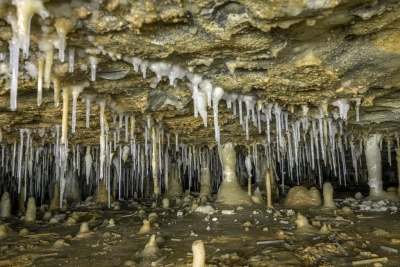
These thin, hollow tubes also form from dissolved particles in water, dripping slowly through the roof of a cave. They may grow into stalactites if the water keeps dripping for a very long time.
These tubes form when calcium carbonate or calcium sulfate dissolved in the water comes out of solution and is deposited. In soda straws, as each drop hovers at the tip, it deposits a ring of mineral at its edge. It then falls and a new drop takes its place. Each successive drop of water deposits a little more mineral before falling, and eventually a tube is built up. Stalagmites or flowstone may form where the water drops hit the cave floor.
Soda straws are some of the most fragile of speleothems. Like helictites, they can be easily crushed or broken by the slightest touch. Because of this, soda straws are rarely seen within arms’ reach in show caves or others with unrestricted access. Kartchner Caverns in southern Arizona has well-preserved soda straws because of its recent discovery in 1974 and highly regulated traffic.
Picture Credit : Google

